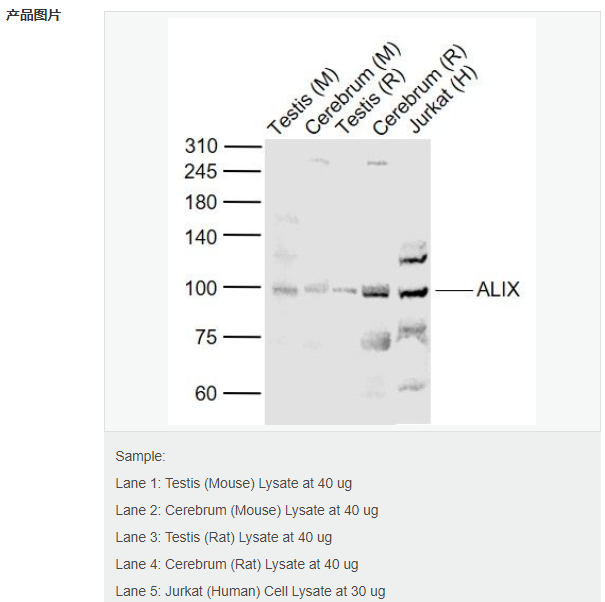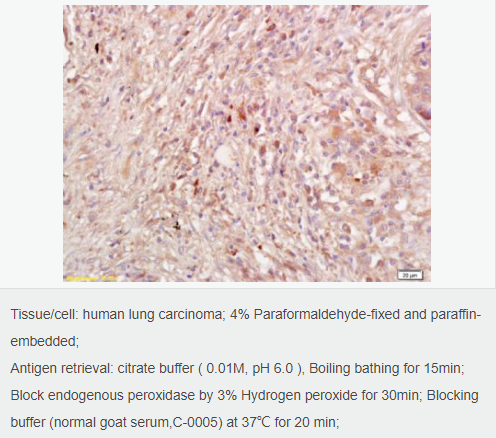
货号
产品规格
售价
备注
BN41232R-100ul
100ul
¥2360.00
交叉反应:Human,Mouse,Rat 推荐应用:WB,IHC-P,IHC-F,IF,ELISA
BN41232R-200ul
200ul
¥3490.00
交叉反应:Human,Mouse,Rat 推荐应用:WB,IHC-P,IHC-F,IF,ELISA
| 英文名称 | ALIX |
| 中文名称 | 调亡诱导因子6相互作用蛋白/多巴胺受体相互作用蛋白4抗体 |
| 别 名 | AIP1; ALG 2 interacting protein 1; ALG-2-interacting protein 1; ALG2 interacting protein X; Alix; Apoptosis linked gene 2 interacting protein X; Dopamine receptor interacting protein 4; DRIP4; HP95; KIAA1375; MGC17003; PDC6I_HUMAN; PDCD6 interacting protein; PDCD6-interacting protein; PDCD6IP; Programmed cell death 6 interacting protein; Programmed cell death 6-interacting protein. |
| 研究领域 | 细胞生物 信号转导 细胞凋亡 转录调节因子 |
| 抗体来源 | Rabbit |
| 克隆类型 | Polyclonal |
| 交叉反应 | Human, Mouse, Rat, |
| 产品应用 | WB=1:500-2000 ELISA=1:5000-10000 IHC-P=1:100-500 IHC-F=1:100-500 IF=1:100-500 (石蜡切片需做抗原修复) not yet tested in other applications. optimal dilutions/concentrations should be determined by the end user. |
| 分 子 量 | 95 kDa |
| 细胞定位 | 细胞浆 |
| 性 状 | Liquid |
| 浓 度 | 1mg/ml |
| 免 疫 原 | KLH conjugated synthetic peptide derived from human PDC6I:601-700/868 |
| 亚 型 | IgG |
| 纯化方法 | affinity purified by Protein A |
| 储 存 液 | 0.01M TBS(pH7.4) with 1% BSA, 0.03% Proclin300 and 50% Glycerol. |
| 保存条件 | Shipped at 4℃. Store at -20 °C for one year. Avoid repeated freeze/thaw cycles. |
| PubMed | PubMed |
| 产品介绍 | Class E VPS protein involved in concentration and sorting of cargo proteins of the multivesicular body (MVB) for incorporation into intralumenal vesicles (ILVs) that are generated by invagination and scission from the limiting membrane of the endosome. Binds to the phospholipid lysobisphosphatidic acid (LBPA) which is abundant in MVBs internal membranes. The MVB pathway appears to require the sequential function of ESCRT-O, -I,-II and -III complexes. The ESCRT machinery also functions in topologically equivalent membrane fission events, such as the terminal stages of cytokinesis and enveloped virus budding (HIV-1 and other lentiviruses). Appears to be an adapter for a subset of ESCRT-III proteins, such as CHMP4, to function at distinct membranes. Required for completion of cytokinesis. Involved in HIV-1 virus budding. Can replace TSG101 it its role of supporting HIV-1 release; this function implies the interaction with CHMP4B. May play a role in the regulation of both apoptosis and cell proliferation. Function: Class E VPS protein involved in concentration and sorting of cargo proteins of the multivesicular body (MVB) for incorporation into intralumenal vesicles (ILVs) that are generated by invagination and scission from the limiting membrane of the endosome. Binds to the phospholipid lysobisphosphatidic acid (LBPA) which is abundant in MVBs internal membranes. The MVB pathway appears to require the sequential function of ESCRT-O, -I,-II and -III complexes. The ESCRT machinery also functions in topologically equivalent membrane fission events, such as the terminal stages of cytokinesis and enveloped virus budding (HIV-1 and other lentiviruses). Appears to be an adapter for a subset of ESCRT-III proteins, such as CHMP4, to function at distinct membranes. Required for completion of cytokinesis. Involved in HIV-1 virus budding. Can replace TSG101 it its role of supporting HIV-1 release; this function implies the interaction with CHMP4B. May play a role in the regulation of both apoptosis and cell proliferation. Subunit: Interacts with SH3KBP1. Interacts with PDCD6 and TSG101 in a calcium-dependent manner. Interacts with and SGSM3. Self-associates. Interacts with CHMP4A; the interaction is direct. Interacts with CHMP4B; the interaction is direct. Interacts with CHMP4C; the interaction is direct. Interacts with HIV-1 p6. Interacts with EIAV p9; the interaction has been shown in vitro. Interacts with CEP55; the interaction is direct; CEP55 binds PDCD6IP in a 2:1 stoechiometry. May interact with PDGFRB. Interacts with SH3GL1 and SH3GL2. Interacts with murine leukemia virus Gag polyprotein (via LYPX(n)L motif). Interacts with murine leukemia virus Gag polyprotein (via LYPX(n)L motif). Subcellular Location: Cytoplasm, cytosol. Melanosome. Cytoplasm, cytoskeleton, centrosome. Note=Identified by mass spectrometry in melanosome fractions from stage I to stage IV. Colocalized with CEP55 in the midbody during cytokinesis. Colocalized with CEP55 at centrosomes of non-dividing cells. Post-translational modifications: May be phosphorylated on tyrosine residues by activated PDGFRB. Similarity: Contains 1 BRO1 domain. SWISS: Q8WUM4 Gene ID: 10015 Database links: Entrez Gene: 10015 Human Entrez Gene: 18571 Mouse Omim: 608074 Human SwissProt: Q8WUM4 Human SwissProt: Q9WU78 Mouse Unigene: 475896 Human Unigene: 29816 Mouse Unigene: 101381 Rat Unigene: 1588 Rat Unigene: 226240 Rat Important Note: This product as supplied is intended for research use only, not for use in human, therapeutic or diagnostic applications. |

